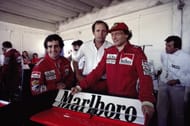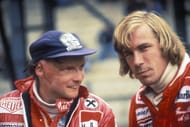Austrian racing driver Niki Lauda is carried into hospital at Ludwigshaven after suffering serious burns when his Ferrari caught fire during the German Grand Prix at Nurburgring, August 1976
As the disheartened doctors waited patiently to perform the last rites on a semi-conscious reigning World Champion, Niki Lauda refused to succumb to his injuries. The crash at Nurburgring in the 1976 Grand Prix had not only scarred him physically, but mentally too.
If his driving was breathtaking, his will to live was even more astounding. None would have envisioned him racing any further, but 42 days on, Lauda was back just before Monza, fighting for a podium finish. His downplaying of the entire incident from there on, till the publication of his autobiography just substantiates his pragmatic approach to racing.
Never has a person had to attract undue sympathy or care from the public. Lauda went on with his career, clinically, meticulously and unemotionally, winning two further championships to end his career as a triple-world champion.
But things were not always the same for this precocious kid born into an influential Viennese family. Racing was not what his family envisioned for him as a profession. Having bought his way into racing with banks loans and working his way through Formula 2 with the March racing team, he quickly grabbed a seat in both F1 and F2 with March.
But his big break came when he joined BRM in 1973, where again he paid for his drive. The big manufacturer though, was in troubled waters then. When his teammate Clay Regazzoni moved to Ferrari, he spoke highly enough of Lauda to convince Enzo Ferrari to get him on board in 1974. With this move, Niki not only found a way to pay back the loan, but also found a competitive car to show his full repertoire of skills.
During his first year with the team from Maranello, it quickly became clear that Lauda was much more than a risky investment for Ferrari, which was how it seemed at that time. He finished fourth in the Drivers’ standings, largely due to the mechanical unreliability of the Ferrari. But few races into the 1975 season, Lauda would get his hands on the Mauro Forghieri-designed Ferrari 312T. With an altered gearbox for the 312T, Lauda led Ferrari to the championship and also won them the Constructors’ title for the first time since 1964.
In the record books, he might be a 3-time world champion, but the fact is, had it not been for his grotesque crash at Nurburgring, in a season where he had a Vettel-esque (of 2011) lead in the championship, he would have cruised to the championship in 1976. But as fate would have it, even after repeated protests by drivers against the race due to lack of safety, the race was given the go ahead. It was on lap 2 that tragedy struck. Lauda’s car swerved on the kerb, hit an embankment and immediately ruptured into flames. Fellow drivers tried to push him from the wreck, but it was a good 40 seconds before the medics could arrive.
By then, Lauda’s face was seriously damaged, and he was rapidly drifting into a semi-conscious state owing to the toxic gases he had inadvertently inhaled. After being in and out of coma for a few days, his health started to get better. To everyone’s surprise, a resilient Lauda was back in the car in just 40 days for the race at Monza. He tried to keep his emotions in check but later acknowledged he was “stricken with fear” in the race at Monza.
Unfortunately, by this time, his early season lead had vanished and he went into the final race at Fuji with a slim 3-point advantage over James Hunt. Lauda then made a decision that would alter his career. In a startling decision, he decided to retire from the race owing to the torrential rain and lack of safety. The decision evoked sharp reaction from the media and his own team. He effectively handed the championship to Hunt, who beat him to the title by a single point.
The crash that nearly took his life.
He faced a rather difficult 1977 with Ferrari. Even though he guided the team to another title, his relationship with Enzo Ferrari had broken down. Ergo, he quit the team to join Ecclestone’s Brabham for a 1m$ salary.
1979 was a disheartening season for him. Having accumulated just 4 points that year, his interest in Formula 1 was on the decline and he announced retirement and revealing to his team, “I’m through, I don’t want to drive around in circles anymore.”
He went on to establish his own airline ‘Lauda Air’ in Austria.
But in 1982, with Lauda well into retirement, Ron Dennis of McLaren approached him with a massive deal, a deal, if Niki dotted, would make him one of the highest paid athletes in the world. He inked the deal. He had to endure 2 seasons without a championship, but he eventually delivered in 1984, beating his new teammate Alain Prost by the closest margin ever recorded in Formula 1 history (just half a point).

Ron Dennis’(center) pursuit to lure Lauda (R) into driving for McLaren turned out to be a master stroke as Niki delivered a championship in 1984.
That would be the last of his successes. Following a torrid 1985 season, Lauda finally bowed out of F1, moving on to manage his airline, and occasionally pilot it too.
His philosophy of “To win a race, you must first finish it”, was the hallmark of his success. His efficient, logical and indifferent approach to racing had its detractors, but he was not a man to sway to public opinion. Trophies had virtually no meaning to him. In his own words, he said ”They were cluttering up my home in Austria”.
A tribute:
Lauda is one of those few drivers whose life is centered around racing, even in retirement. He immediately took up commentating upon retirement. A constant figure in the paddock, he held position as the team principal of Jaguar racing team and also a consultant to Mercedes AMG.
We often talk of comeback kings in sports. But Lauda not only came back from retirement to win the title, he did so by cheating death in the process. It’s the reason why drivers around the globe still consider the Austrian an inspiration.
Why Niki Lauda is one of the top pilots ever to enter the cockpit of an F1 car:
Being born into a wealthy family is always a cushion for a young lad. But Lauda chose the tougher path. He went against the wishes of his family into a sport notorious for taking the lives of its drivers. He lives on to tell his tale without regret.
For a man of his stature, his disregard for his public image and the trophies he possessed was something of a revelation.
With a style of driving similar to Jackie Stewart’s, he could grind down the faster rivals with his phenomenal consistency, lap after lap. He often did just enough to win a race. He did not put his chances in jeopardy with any unnecessary show of blinding laps when in the lead. Again, it’s testimony to his scientific outlook to racing.
On the back of his horrendous crash at Nurburgring, it would have been much easier for him if he just quit. But Lauda thought otherwise. Till date, his comeback just weeks after his crash in the 1976 German GP is one of the towering moments in Formula 1 history.
He is still a regular face in the paddock and has served the sport in various capacities since retirement.
He had the audacity to refuse to drive at the final race of 1976, greatly angering Enzo Ferrari. No other driver would have got a second chance to drive for Ferrari under such circumstances. Lauda won the championship in 1977 and left the team on his own terms.
With the kind of stellar career he has had, constantly rising from the hapless setbacks he faced, he has been looked upon by generations of drivers as a benchmark of efficiency and bravery. With the Ron Howard directed movie ‘Rush’ on the 1976 Formula 1 season featuring the Hunt and Lauda rivalry slated for release next year, Formula 1 fans have their hands full to watch a biopic of one of the all time giants of racing.

